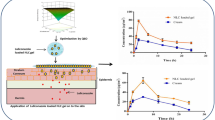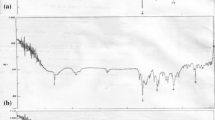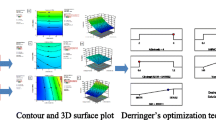Abstract
Low permeability is one of the barriers to the bioavailability of drugs through the oral route. The purpose of the present study was to design and optimize a sustained release and highly permeable hydrogel formulation of ganciclovir (GCV) by using response surface methodology (RSM). Carbopol 934P was used as a gelling agent, with two permeation enhancers, i.e., propylene glycol (PG) and oleic acid (OA), which were selected as variables X1 and X2, respectively. A total number of 13 runs prepared by using a central composite rotatable design (CCRD), followed by the preparation and evaluation of various parameters, including flux, lag time, Kp, and the rheological studies were evaluated. FTIR analysis showed that there was no interaction between the drug, polymer, and other excipients. The outcomes of ex vivo permeation studies have reviled that the values of flux, lag time, and kp were found to be 2.08800 ± 0.008, −6.982638 ± 0.01, −2.6917 ± 1.21, −29.7116 ± 0.68, and 0.00020, −0.00069, respectively. The spreadability index and the viscosity of the gel formulations were between the range of 2.63 ± 0.12–3.50 ± 0.08 and 5013.66 ± 1.69–5077.66 ± 2.05, respectively. On the other hand, the pH of all preparations was maintained at 7.02–7.13 pH to avoid skin irritation. After evaluating the said parameters, the composition for the optimized formulation is PG 5gm, OA 0.4gm, and carbopol 0.5gm. Furthermore, the findings have advocated that the hydrogels could be used, not only to deliver the drug in a sustained manner but also to improve the permeation of the drug and hence its bioavailability.












Similar content being viewed by others
References s
Abdul-Aziz BI, Rajab NA (2014) Preparation and in-vitro evaluation of mucoadhesive clotrimazole vaginal hydrogel. Iraqi J Pharm Sci 23:1–7
Ahmad F, Alam M, Khan Z, Khar R, Ali M (2008) Development and in vitro evaluation of an acid buffering bioadhesive vaginal gel for mixed vaginal infections. Acta Pharm 58(4):407–419
Ansari H, Singh P (2018) Formulation and in-vivo evaluation of novel topical gel of lopinavir for targeting HIV. Curr HIV Res 16(4):270–279
Carpentieri-Rodrigues LN, Zanluchi JM, Grebogi IH (2007) Percutaneous absorption enhancers: mechanisms and potential. Braz Arch Biol Technol 50(6):949–961
Chang J, Wu P, Huang Y, Tsai Y (2006) In-vitro evaluation of meloxicam permeation using response surface methodology. J Food Drug Anal 14(3):236
Cullity B (1978) Elements of x-ray diffraction, 2nd. Adisson-Wesley Publis hing, USA
Dantas MGB, Reis SAGB, Damasceno CMD, Rolim LA, Rolim-Neto PJ, Carvalho FO, Almeida JRGDS (2016) Development and evaluation of stability of a gel formulation containing the monoterpene borneol. Sci World J. https://doi.org/10.1155/2016/7394685
Dash S, Murthy PN, Nath L, Chowdhury P (2010) Kinetic modeling on drug release from controlled drug delivery systems. Acta Pol Pharm 67(3):217–223
Deuschle VCKN, Deuschle RAN, Bortoluzzi MR, Athayde ML (2015) Physical chemistry evaluation of stability, spreadability, in vitro antioxidant, and photo-protective capacities of topical formulations containing Calendula officinalis L. leaf extract. Braz J Pharm Sci 51:63–75
El-Houssieny BM, Hamouda HM (2010) Formulation and evaluation of clotrimazole from pluronic F127 gels. Drug Discov Ther 4(1):33–43
Elkheshen SA (2001) Interaction of verapamil hydrochloride with Carbopol 934P and its effect on the release rate of the drug and the water uptake of the polymer matrix. Drug Dev Ind Pharm 27(9):925–934
Fox LT, Gerber M, Plessis JD, Hamman JH (2011) Transdermal drug delivery enhancement by compounds of natural origin. Molecules 16(12):10507–10540
Gannu R, Yamsani VV, Yamsani SK, Palem CR, Yamsani MR (2009) Optimization of hydrogels for transdermal delivery of lisinopril by box-behnken statistical design. AAPS Pharm Sci Tech 10(2):505–514
Hosmani AH, Thorat Y, Kasture P (2006) Carbopol and its pharmaceutical significance: a review. Pharm Net 4(5):1–10
Ibrahim MM, Hafez SA, Mahdy MM (2013) Organogels, hydrogels and bigels as transdermal delivery systems for diltiazem hydrochloride. Asian J Pharm Sci 8(1):48–57
Ibrahim SA, Li SK (2010) Efficiency of fatty acids as chemical penetration enhancers: mechanisms and structure enhancement relationship. Pharm Res 27(1):115–125
Kamboj S, Sharma D, Bala S, Ansari S, Ali J, Pramod K, Sharma R (2012) Optimization of disodium edetate topical gel using central composite design and evaluation for external radioactive decontamination. Elixir Pharm 42:6144–6150
Khalifa MK (2015) Miconazole nitrate based cubosome hydrogels for topical application. Int J Drug Deliv 7(1):01–12
Khan AW, Kotta S, Ansari SH, Sharma RK, Kumar A, Ali J (2013) Formulation development, optimization and evaluation of aloe vera gel for wound healing. Pharmacogn Mag 9(Suppl 1):S6
Khan S, Trivedi V, Boateng J (2016) Functional physico-chemical, ex vivo permeation and cell viability characterization of omeprazole loaded buccal films for paediatric drug delivery. Int J Pharm 500(1–2):217–226
Khushbu PS, Rashmi SS, Ulhas GK (2014) Natural gelling agents: a review. Int J Univ Pharm Biosci 03(03):318–337
Larrucea E, Arellano A, Santoyo S, Ygartua P (2001) Combined effect of oleic acid and propylene glycol on the percutaneous penetration of tenoxicam and its retention in the skin. Eur J Pharm Biopharm 52(2):113–119
Makky A, Mohamed M, Abdellatif M (2014) Liposomal gels as carriers for safer topical delivery of tazarotene. J Pharm Res Opin 3(12):1–10
Marks R (2004) The stratum corneum barrier: the final frontier. J Nutr 134(8):2017S-2021S
Moghadam SH, Saliaj E, Wettig SD, Dong C, Ivanova MV, Huzil JT, Foldvari M (2013) Effect of chemical permeation enhancers on stratum corneum barrier lipid organizational structure and interferon alpha permeability. Mol Pharm 10(6):2248–2260
Mohammed WH, Ali WK, Al-Awady MJ (2018) Evaluation of in vitro drug release kinetics and antibacterial activity of vancomycin HCl-loaded nanogel for topical application. J Pharm Sci Res 10(11):2747–2756
Murthy GL, Vamsi VR, Devi T, Babu NN, Ch S, Masthaniah K, Kumar PK (2014) Design and evaluation of diclofenac sodium buccal mucoadhesive film by solvent casting technique. Int J Pharm Sci Res 5(5):1767
Nnamani P, Kenechukwu F, Anugwolu C, Attama A (2014) Evaluation of hydrogels based on poloxamer 407 and polyacrylic acids for enhanced topical activity of gentamicin against susceptible infections. Trop J Pharm Res 13(9):1385–1391
Olejnik A, Kapuscinska A, Schroeder G, Nowak I (2017) Physico-chemical characterization of formulations containing endomorphin-2 derivatives. Amino Acid 49(10):1719–1731
Pande V, Patel S, Patil V, Sonawane R (2014) Design expert assisted formulation of topical bioadhesive gel of sertaconazole nitrate. Adv Pharm Bull 4(2):121
Preeti MSK (2014) Development of celecoxib transfersomal gel for the treatment of rheumatoid arthritis. Indian J Pharm 2(2):7–13
Rajab NA, Hussein AA (2019) Formulation and in-vitro evaluation of darifenacin hydrobromide as buccal films. Iraqi J Pharm Sci (IJPS) 28(2):83–94
Sanghai NN, Wani NS, liag AP (2014) Design and optimization of microemulsion formulation for topical delivery of lornoxicam. World J Pharm Res 03(06):457–474
Shabbir M, Sajid A, Hamid I, Sharif A, Akhtar MF, Raza M, Amin MU (2019) Influence of different formulation variables on the performance of transdermal drug delivery system containing tizanidine hydrochloride: in vitro and ex vivo evaluations. Braz J Pharm Sci. https://doi.org/10.1590/s2175-97902018000400130
Shokri J, Azarmi S, Fasihi Z, Hallaj-Nezhadi S, Nokhodchi A, Javadzadeh Y (2012) Effects of various penetration enhancers on percutaneous absorption of piroxicam from emulgels. Res Pharm Sci 7(4):225
Sindhu R, Binod P, Pandey A (2015) Microbial poly-3-hydroxybutyrate and related copolymers. Industrial biorefineries & white biotechnology. Elsevier, New York, pp 575–605
Songkro S (2009) An overview of skin penetration enhancers: penetration enhancing activity, skin irritation potential and mechanism of action. Songklanakarin J Sci Technol 31(3):299–321
Soni H, Singhai A (2013) Formulation and development of hydrogel based system for effective delivery of rutin. Int J Appl Pharm 5:5–13
Thakur NK, Bharti P, Mahant S, Rao R (2012) Formulation and characterization of benzoyl peroxide gellified emulsions. Sci Pharm 80(4):1045
Trommer H, Neubert R (2006) Overcoming the stratum corneum: the modulation of skin penetration. Skin Pharmacol Physiol 19(2):106–121
Vollmer U, Müller B, Mesens J, Wilffert B, Peters T (1993) In vivo skin pharmacokinetics of liarozole: percutaneous absorption studies with different formulations of cyclodextrin derivatives in rats. Int J Pharm 99(1):51–58
Xiao Y, Lin Z, Liu J, Zhang W, Wang L, Yu P (2012) A transdermal microemulsion-based hydrogel of nisoldipine: preparation, in vitro characterization and in vivo pharmacokinetic evaluation. Asian J Pharm Sci 7(5):316–328
Zhu W, Guo C, Yu A, Gao Y, Cao F, Zhai G (2009) Microemulsion-based hydrogel formulation of penciclovir for topical delivery. Int J Pharm 378(1):152–158
Acknowledgements
The authors are thankful to the Faculty and Lab staff of The University of Lahore for their support to accomplish the task.
Author information
Authors and Affiliations
Corresponding author
Ethics declarations
Ethical approval
This study was approved by The University of Lahore, Lahore, Pakistan, by Research and ethics committee under reference no, Reference # UOL/REC/23/09/2019.
Additional information
Publisher's Note
Springer Nature remains neutral with regard to jurisdictional claims in published maps and institutional affiliations.
Rights and permissions
Springer Nature or its licensor (e.g. a society or other partner) holds exclusive rights to this article under a publishing agreement with the author(s) or other rightsholder(s); author self-archiving of the accepted manuscript version of this article is solely governed by the terms of such publishing agreement and applicable law.
About this article
Cite this article
Siddique, W., Zaman, M., Waheed, S. et al. Development and optimization of ganciclovir-loaded carbopol topical gel by response surface methodology for enhanced skin permeation. Polym. Bull. 80, 11817–11844 (2023). https://doi.org/10.1007/s00289-022-04612-5
Received:
Revised:
Accepted:
Published:
Issue Date:
DOI: https://doi.org/10.1007/s00289-022-04612-5




